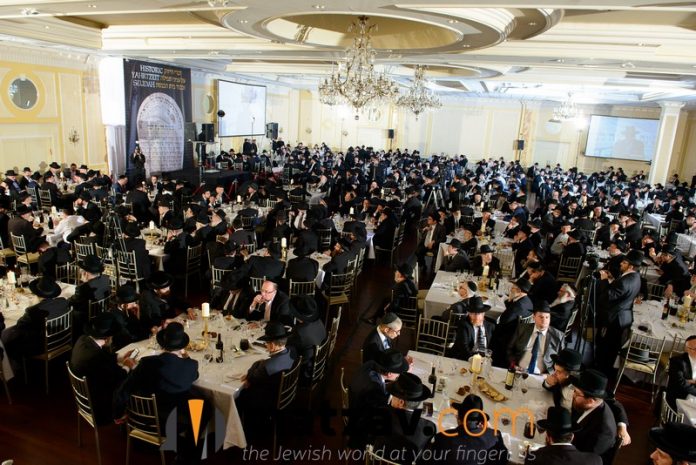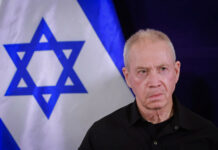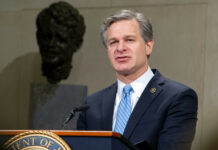
On Vav Elul, August 28th, a massive event from the “Stop the Talking In Shul” organization was held in Ateres Avrohom Hall, commemorating the yahrtzeit of Rav Yom Tov Heller zt”l, the author of the Tosfos Yom Tov (a famous commentary on Mishnayos).
The historic event was a great success, as more than a thousand people attended. They represented all different walks of Jewish life, including Litvishe, Sefardishe and Chassidishe Yidden. Apparently, the importance of davening and maintaining kavod for the Beis HaKenesses is a theme that resonates throughout the gamut of Torah communities.
The atmosphere was electric, as everyone came for the Leshaim Shamayim purpose of increasing honor for davening and maintaining and/or restoring honor for our Batei Kenaisios and Batei Midrash, which tied in to the yahrtzeit of the Tosfos Yom Tov. As discussed later by the Darshanim, the Tosfos Yom Tov was well known for his famous Mi Shebairach which he composed in honor of those that show proper respect for shuls and don’t speak during davening and Krias HaTorah. In addition, many people lit Neiros, candles in honor of the Baal Hilula, the Tosfos Yom Tov.
This event was also streamed on Matzav.com, where thousands more all over the world were able to vicariously “attend” and connect to this important Maamad.
The Mizamrim choir – accompanied by Chazan Tzvi Weiss from Yerushalayim – sang hertzige, soul stirring nigunim, which elevated everyone. One of these nigunim was “Shaarei demaos lo ninalu,” the gates of tears are not closed. This reminded us of the tears so many Yidden are shedding for various tzaros, including for people that need shidduchim, refuos for various sicknesses r”l, shalom bayis, a yeshua for children that have strayed from the Derech Hayashar r”l, and many other tzaros r”l. Of course this gave all the attendees a feeling of the importance of our tefilos which we extend for these tzaros, and how we must maximize our concentration and participation in davening and in our Batei Kenesses.
The event began with Tefilas Mincha and Tehilim. Rav Shimon Gallai Shlita, a well-known Marbitz Torah in Eretz Yisroel was honored to say the Tehilim, and Rav Eliezer Dovid Rapaport Shlita, Mora Deasra of Kahal Zichron Avrohom Yaakov of Flatbush was honored to read the misheberach for Cholei Yisroel. A siyum was made by Rav Pesach Chase of Toronto and Kaddish was said by Rav Shimon Krausz, a descendant of the Tosfos Yom Tov.
The Master of Ceremonies, Aaron Kotler, C.E.O. of Beis Medrash Gavoha of Lakewood, began by discussing the importance of the Baal Hilula, the Tosfos Yom Tov. He was a person who was one of the great Rabbanim of his time, and served in important kehillos in many important parts of the Torah world in his generation. Of course, he also wrote many important Torah works, including most famously the Tosfos Yom Tov on Mishnayos.
Afterwards, three outstanding Torah leaders, discussed the issues which united thousands for this important occasion. While there is not enough space to mention everything that was said, the following are some of the important points these Darshanim mentioned:
Rav Noach Isaac Oelbaum, Mora Deasra of Kehal Nachalas Yitzchok, and a renowned darshan, discussed how the maamad, was truly historic. While Klal Yisroel has had massive events for Siyumei Hashas and other important reasons, this is the first time so many people got together to emphasize the importance of not talking in shul and treating our Batei Kenasios and Batei Midrashos with the proper respect. We can only imagine the great impact this event is making in Shamayim, the heavens.
Rav Oelbaum mentioned a gevaldige vort from the Satmar Rav zt”l (the “Divrei Yoel”) on the famous Gemara which states that eventually, in the times of Moshiach, all the Batei Kenesses and Batei Medrash in Chutz Laaretz, the Diaspora, will be reestablished in Eretz Yisroel. Asks the Satmar Rav, why is it necessary for this to occur? Why can’t we just establish brand new Batei Kenesses/shuls/Batei Midrash for all the Yidden who will then live in Eretz Yisroel? Why is it necessary to bring all the old shuls and Batei Midrash from Chutz Laaretz? He answers that nowadays our avodah in Chutz Laaretz has a maalah, advantage of overcoming great nisyonos, trials from the yetzer hora (and our galus). Leasid Lavo, eventually in the times of Moshiach, while it will be an elevated time, nonetheless there will be a feeling that we are lacking the maalah of overcoming such great nisyonos. This is why, when Moshiach comes, all the Batei Kenaisios and Batei Midrashos from Chutz Laaretz will miraculously be transported to Eretz Yisroel. This will enable the Yidden in Eretz Yisroel to reconnect to the great avodah of the Yidden throughout the Galus, in which they overcame such great nisyonos and served Hashem with such mesirus nefesh, self sacrifice.
Rav Oelbaum said that despite the fact that we hope this will happen soon, we must realize that we cannot be assured that every Beis Kenesses and Beis Medrash will merit this to happen. The Rav quoted from the Noda BiYehuda zt”l that when people speak in the shul, showing disrespect to the Beis Kenesses and Tefilah, there is no greater Meridah, rebellion to Hashem than this. They are Metamei the Avir HaKodesh, make profane the holy air of the Beis Kenesses, which starts with great holiness. {In order for the shuls to be reestablished in Eretz Yisroel, they have to maintain their Kedusha. Those shuls that have maintained decorum and respect to the shul and to davening, have great kedusha and deserve to be reestablished in Eretz Yisroel. Chas Veshalom, those shuls and Batei Midrash that have been desecrated by speaking during davening and Krias HaTorah have lost their kedusha and therefore may not deserve the kavod of being reestablished in Eretz Yisroel in the time of Moshiach.}
Rav Oelbaum continued in quoting from the Derech Moshe (a very important sefer which is quoted by numerous seforim, like the Yesod Veshoresh HaAvodah). He writes that Hashem is able kiveyachol to be melameid zechus, find merit for Klal Yisroel in the various aveiros they do, r”l. If they steal, Hashem said that if I would have given the Torah to the Umos HaOlam, they would have also stolen. However, if the Satan argues that Klal Yisroel speaks in shul during the davening, there is no answer to the Satan, as the Umos Haolam (in lehavdil their places of worship) do show respect and are quiet during their services. What can be said to the argument of the Satan that why can’t the Yidden also be quiet when they are davening? This can cause chas veshalom a terrible kitrug in shamayim, causing forces of destruction to be sent into the world, r”l. The word Dever, pestilence, is related to Dibur, speech. This is so, as incorrect speech during davening, prayer, can cause pestilence and forces of destruction to be sent to the world, r”l.
Midah Tovah Merubah, the midah of Hashem bringing good to the world is so much greater than the midas puraniyos, the forces of judgment and punishment. If Klal Yisroel is careful in guarding the respect of the Batei Kenaisios, Batei Midrashos and the respect for Tefilah, this will certainly bring refuos, yeshuos and great and good things for all Yiddishe Kinder, members of Klal Yisroel. Then all the Batei Kenaisios and Batei Midrashos will be reestablished in Eretz Yisroel with the coming of Moshiach Tzidkeinu Bimehayra Beyameinu Amen.
The next speaker was Rav Yitzchok Sorotzkin Shlita, who is a prolific writer and a Marbitz Torah in Lakewood. Rav Sorotzkin discussed the statement of Chazal that the various berachos, blessings of Bilam Harasha were eventually turned into kelalos, curses r”l. However, one blessing remained totally a beracha, the beracha of Mah Tovu Ohalecha Yaakov (which is still mentioned as part of our tefilos every morning). Why wasn’t this also turned into a curse? We can answer that this beracha relates to the greatness of the tents of Klal Yisroel, which hints to our Batei Keneses and Batei Midrashos. These heilige, holy places are so important that they are the foundation of Klal Yisroel. Since the Kiyum, existence of the entire world is based upon these Batei Keneses and Batei Midrash, the beracha related to them cannot be taken away, as otherwise the world won’t exist.
If we understand the importance of these holy places, we can also understand why the yetzer hora and the satan puts so much emphasis on being machshil, causing Jews to stumble and fall in regards to this important area. The Vilna Gaon zt”l explains as follows: Chazal tell us that one who is greater than his friend has a bigger yetzer hora than his friend. On a simple level, this means that people that are greater spiritually have greater yetzer hora’s. {This is done so that everyone will have bechirah, free will to choose between equal forces of good and evil.} The GR”A zt”l writes that this statement of Chazal also refers to various mitzvos in the world. The greater a mitzvah is, the more there is a yetzer hora to violate it. {The yetzer hora realizes how important the mitzvah is, and therefore puts greater emphasis on fighting against it.} This certainly applies to the area we are discussing. Since showing respect to Batei Kenesses, Batei Midrash and Tefilah is so important and necessary for the very existence of the world, therefore the yetzer hora puts great emphasis on trying to cause Yidden to speak in shuls and show a lack of respect to Batei Keneses and Batei Midrash.
By talking in shul improperly, one is showing terrible disrespect to the very purpose of our creation, which is for Kavod Shamayim. This is the reason that there is such a terrible Midas HaDin, judgment which is created if Yidden speak during davening and show disrespect to the Beis Kenesses and Beis Midrash, chas veshalom.
Many great Tzadikim, including the Gerrer Rebbe zt”l, said that the Holocaust happened due to the Midas Hadin created due to showing disrespect to Batei Kenaisios and Batei Midrashos. This was also the reason that the Holocaust didn’t effect Acheinu Bnai Yisroel from the lands of the Sefardim (to such a great extent), as they showed respect to Tefilah, the Beis Keneses and the Beis Medrash.
Guarding ourselves from talking during davening is also a gevaldige zechus and segulah for Arichus Yomim, long life. A hint to this is that the word “Saivah” (an elder person) is Notrikun Shtikah Yafah Bishas HaTefilah (Being Quiet is Beautiful During our Prayer).
In the zechus of showing proper respect to Tefilah, Batei Kenesses and Batei Midrash, the miniature Batei Mikdash of our time (as Chazal say), we should soon be zoche to see the rebuilding of the Beis HaMikdash speedily in our times.
The next speaker was Rav Gamliel Rabinowitz Shlita, a world renowned Marbitz Torah and mechaber from Yerushalayim. Through a live satellite transmission, Rav Gamliel spoke about the importance of spending time every day in discussing the importance of tefilah and learning Biur Tefilah, the meaning of the words of our tefilos. Just as thousands of Yidden (Bli Ayin Hara) learn Daf Yomi and Halacha Yomi every day, so too Yidden have to learn about davening every day. We should discuss this issue with our children, and certainly show a good example to them from our behavior in Batei Keneses and Batei Midrash.
Rav Rabinowitz took out a Sefer Torah from the Aron Kodesh and then read from the famous Mi Shebairach of the Tosfos Yom Tov about not talking during davening and Krias HaTorah. This Mi Shebairach, blesses those that are careful in these regards to have long life, gezunt (good health) and nachas from their children.
We are mispallel that the zechus of this Maamad should stand for Klal Yisroel for a Kesivah VaChasimah Tovah. We should all be zoche, in the zechus of continuing on the message of showing respect to tefilah and our Batei Keneses and Batei Midrash, to have Gezunt, Arichus Yamim, Nachas and the Geulah Shelaimah Bimehayra Beyameinu Amen.
SIDEBAR
The Mi Shebairach of the Tosfos Yom Tov
Rav Yom Tov Lipman Heller zt”l, the Baal Tosfos Yom Tov, lived during the times of Tach VeTat, the infamous Chelmenitzky massacres, r”l. These massacres caused terrible damage to Klal Yisroel, killing hundreds of thousands of Yidden. We can perhaps relate to these massacres, as akin to the Holocaust, which happened not so long ago.
We know that there is a reason for all Tzaros, and as Rav Chaim Shmuelevitz zt”l used to say, it is only Gedolei Torah and our Rebbeim that can interpret these events properly. When Tach VeTat happened (in the years 1648-1649, lemisparam), the Baal Tosfos Yom Tov realized the importance of interpreting this event properly. Based upon his own tzidkus, he was zoche to discover (some say with a shailas chalom, a question posed and answered in a dream) that the reason for this tragedy was due to showing a lack of respect to Batei Kenaisios and Batei Midrashos, including talking during davening (prayer) and Krias HaTorah (reading the Torah).
As a result of this revelation, the Tosfos Yom Tov composed a special Mi Shebairach that is still read in many Batei Keneses and Batei Midrash even nowadays.
The following is a running translation of this Mi Shebairach: Mi Shebairach Avoseinu, Avrohom, Yitzchok VeYaakov, Moshe, Aharon, Dovid, U’Shelomo (The One (Hashem) who blessed our fathers…) Hu Yevarech (He should bless) Kol Mi Sheshomeir Piv U’Leshono Shelo Ledabeir Beishas haTefilah U’Krias HaTorah (all who are careful to guard their mouth and tongue from speaking during the times of prayer and reading the Torah). HaKadosh Boruch Hu Yishmeraihu Mikol Tzarah Vetzukah U’Mikol Nega U’Machalah (The Holy One Blessed Be He (Hashem) should guard him from all tribulations and tragedies, and from all sicknesses and maladies). Veyachulu Alav Kol Haberachos Hakesuvos BeSefer Toras Moshe Rabbeinu U’Bechol Sifrei HaNeviim VehaKesuvim (And it should come on him all the blessing that are written in the Book of The Sefer of the Torah of Moshe Rabbeinu and in all the Sefarim of the Neviim and Kesuvim). Veyizkeh Lebanim Chayim Vekayamim (and he should merit to have sons that are alive and well). Viyegadleim LeTorah U’Lechupah U’Lemaasim Tovim (and he should raise them to Torah, marriage and good deeds), Veyaavod Es Hashem Elokeinu Tamid Beemes U’Betamim, Venomar Amen (and he should merit to serve Hashem our G-d, always, with truth, and with perfection and we should say Amen).
This Mi Shebairach is telling us that in the zechus of showing respect to the Beis Kenesses and Beis Midrash and not talking during tefilah and Krias HaTorah, we will merit to be guarded from sicknesses. Another beracha will be to merit raising our children properly, to Torah, Chupah and Maasim Tovim. This is always an important beracha, and how much more so in our day and age when we are so concerned about children that have left the Derech HaYashar r”l. The zechus of Tefilah and treating our Batei Keneses and Batei Midrash properly stands to help our children merit to be raised properly, and to be successful both physically and spiritually. Not talking in shul and treating the Beis Keneses and Beis Midrash properly is a source of all the berachos written in the Torah, Neviim and Kesuvim.
In the zechus of being inspired by the Mi Shebairach of the Tosfos Yom Tov to act properly in our Mekomos HaKedoshim (including shuls and Batei Midrash) we should soon see the rebuilding of the ultimate Makom Kadosh, the Beis HaMikdash, Bimehayra Beyameinu.













{Matzav.com}












Beautiful!
“the Baal Hilula, the Tosfos Yom Tov.”
The Tosfos Yom Tov was not Hasidic. As MC Rabbi Aaron Kotler stated at the event, Rav Yom Tov Lipman Heller zt”l was born in Bavaria (Germany), years before the modern Hasidic movement started, so he was a Yekke, who davened nusach Ashkenaz, and didn’t do hilulas.
I don’t understand why all of a sudden, after promoting the event as a commemoration of his yahrzeit, a serious event, all along, there is suddenly this switch to the Hasidic language of hilula, which is a celebration. I happened to catch a lot of it online last night and don’t recall that terminology being used.
It is not appropriate to convert the Tosfos Yom Tov posthumously into a Hasid, without his permission.
I strongly protest this change.
היללו כבר כתוב בזוהר אין בזה שום שייכת לחסידות אבל חבל חבל שרואים שהכתה הזאת נכתב עם הרבה שנץץץ ”
המנהג של יאהרצייט של אשכנז, שהתוספות יום טוב היה שייך לזה העדה, הוא שונה ומנוגד למנהג של הילולא הנהוג אצל חסידים וספרדים
המנהג של יאהרצייט הכולל תענית לבנים של נפטר הוא מבוסס על חז”ל בהגמרא של הריני עלי כיום שמת בו אביו או רבו וכו
יש להילולא שייכות רבה לחסידות שהם שינו ממנהג הקדום של יאהרצייט לעשותו ליום שמחה מנגד למסורה הישנה של יהדות באשכנז